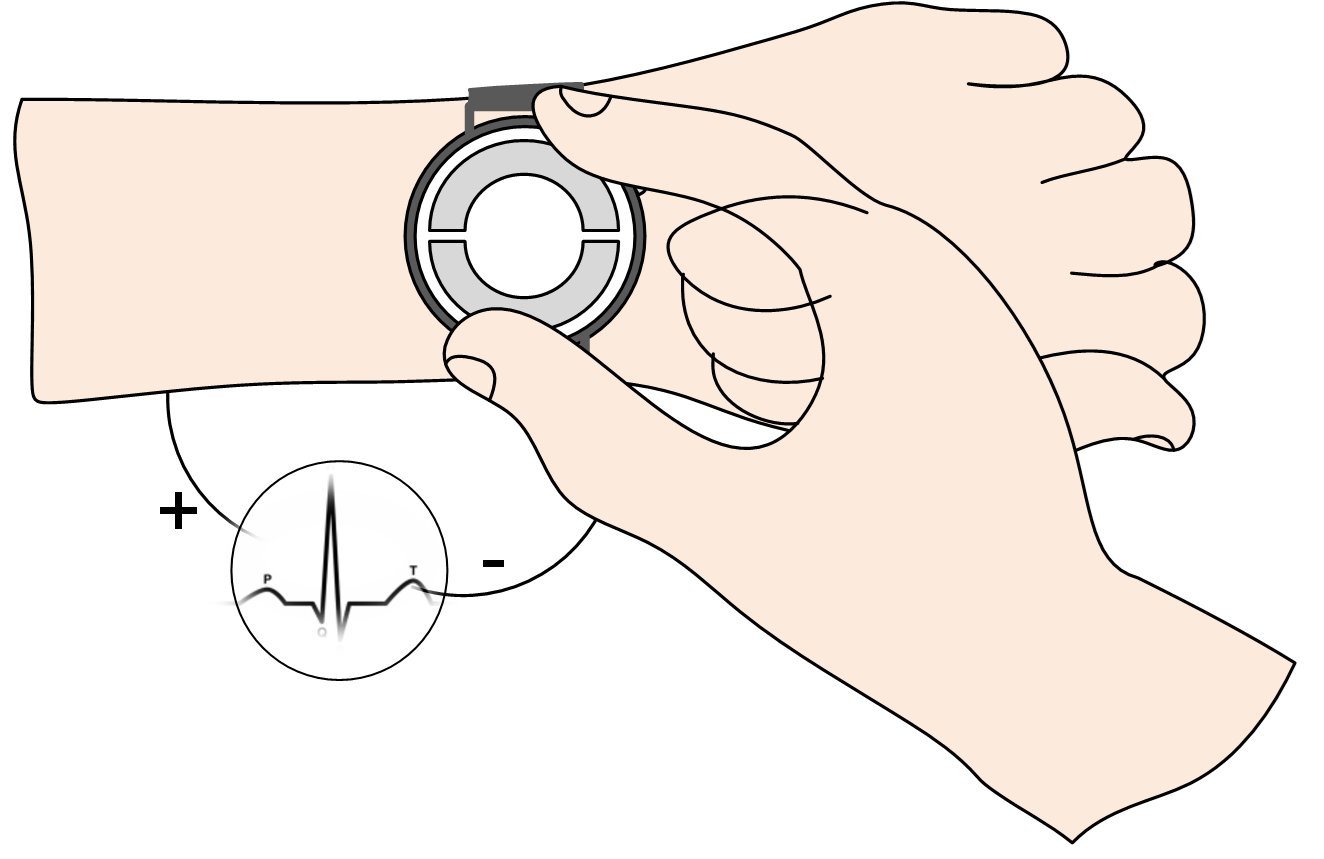SBAA567 November 2022 AFE4950 , AFE4960 , AFE4960P
1 Application Brief
Application
An Electrocardiogram (ECG) records the activity in the heart through the acquisition of electrical signals. Conventional ECG systems like patient monitors involve the connection of multiple electrodes to the patient. The signal acquired between a pair of electrodes is representative of the activity of the heart along the vector connecting the pair of electrodes and gives a unique diagnostic view of the heart. The activity of the heart that can be most easily recorded using a wearable device is along the vector between the right arm (RA) and the left arm (LA). An electrode at the bottom of the device makes continuous contact to the wrist on which the device is worn. Whenever the ECG signal needs to be recorded, a finger of the other hand makes contact to an electrode on the top side of the device. While the RA and LA electrodes are used for sensing the ECG signal, a third electrode (for example, also contacting the wrist) can be used to drive the DC potential of the body. Referred to as the right leg (RL) electrode, the name is derived from the positioning of the electrode on the right leg in clinical ECG systems.
Figure 1-1 shows the ECG acquisition on a wearable device.
 Figure 1-1 ECG Acquisition on a Wearable
Device
Figure 1-1 ECG Acquisition on a Wearable
DeviceThe AFE4950 is a photoplethysmography (PPG) + ECG analog front end from TI that is design for ECG-signal acquisition from a wearable device. The AFE4950 signal chain has several features for acquiring ECG signals from small form-factor electrodes.
AFE4950 Overview
- Interface: SPI™, I2C interfaces: Selectable by pin
- Package: 2.6-mm × 2.5-mm DSBGA, 0.4-mm Pitch
- Supplies: RX: 1.7 V–3.6 V, TX: 3.0 V–5.5 V
- First in, first out (FIFO) with 256-sample depth
- Internal low dropout (LDO)
- High-quality ECG signal acquisition from small form-factor electrodes with high contact impedance – high input impedance, right leg drive (RLD) electrode to improve common-mode rejection ratio (CMRR)
- DC offset removal using integrated high-pass filter (HPF) with fast recovery allows high-gain setting resulting in low noise
- Integrated low-pass filter (LPF) filters high-frequency noise
- AC, DC lead detect and lead-impedance measurement
- Synchronized ECG and photoplethysmography (PPG) signal acquisition enables pulse transit time (PTT) based blood pressure (BP) estimation
Figure 1-2 shows the interface of the analog front end (AFE) to the three ECG electrodes. The positive and negative ECG electrodes interface with the instrumentation amplifier of the AFE4950. A third RLD electrode is driven by the RLD output buffer which operates in a feedback configuration around the human body to suppress any common-mode signal picked up by the body.
Table 1-1 lists the specifications for ECG acquisition on a wearable device.
| System Specification | AFE4950 | Comments |
|---|---|---|
| Number of electrodes | 3 | 2 electrodes for ECG signal acquisition, and a third electrode to drive RLD |
| Input referred noise | 0.7 μVRMS | In 150-Hz bandwidth |
| Input impedance | 10 GΩ at DC, 2 GΩ at 60 Hz | High input impedance helps achieve excellent CMRR even with high and mismatched electrode contact impedances |
| CMRR | 130 dB | With RLD electrode driven through feedback loop |
Figure 1-3 shows the reference schematic of an ECG acquisition system using AFE4950.
Figure 1-4 shows the AFE4950 signal chain for ECG signal acquisition. The signal chain comprises an instrumentation amplifier (INA) with programmable gain, a LPF (which acts as an anti-aliasing filter), and an analog-to-digital converter (ADC) which gives a 24-bit output. An HPF built into the INA is used to remove electrode DC offsets thereby enabling a higher gain setting in the INA. Apart from the RLD function, the AFE4950 also has other useful functions for ECG, such as lead biasing and lead On or Off detection.
Other AFEs from TI that support ECG signal acquisition on wearables include the AFE4960, AFE4960P, and AFE4500.